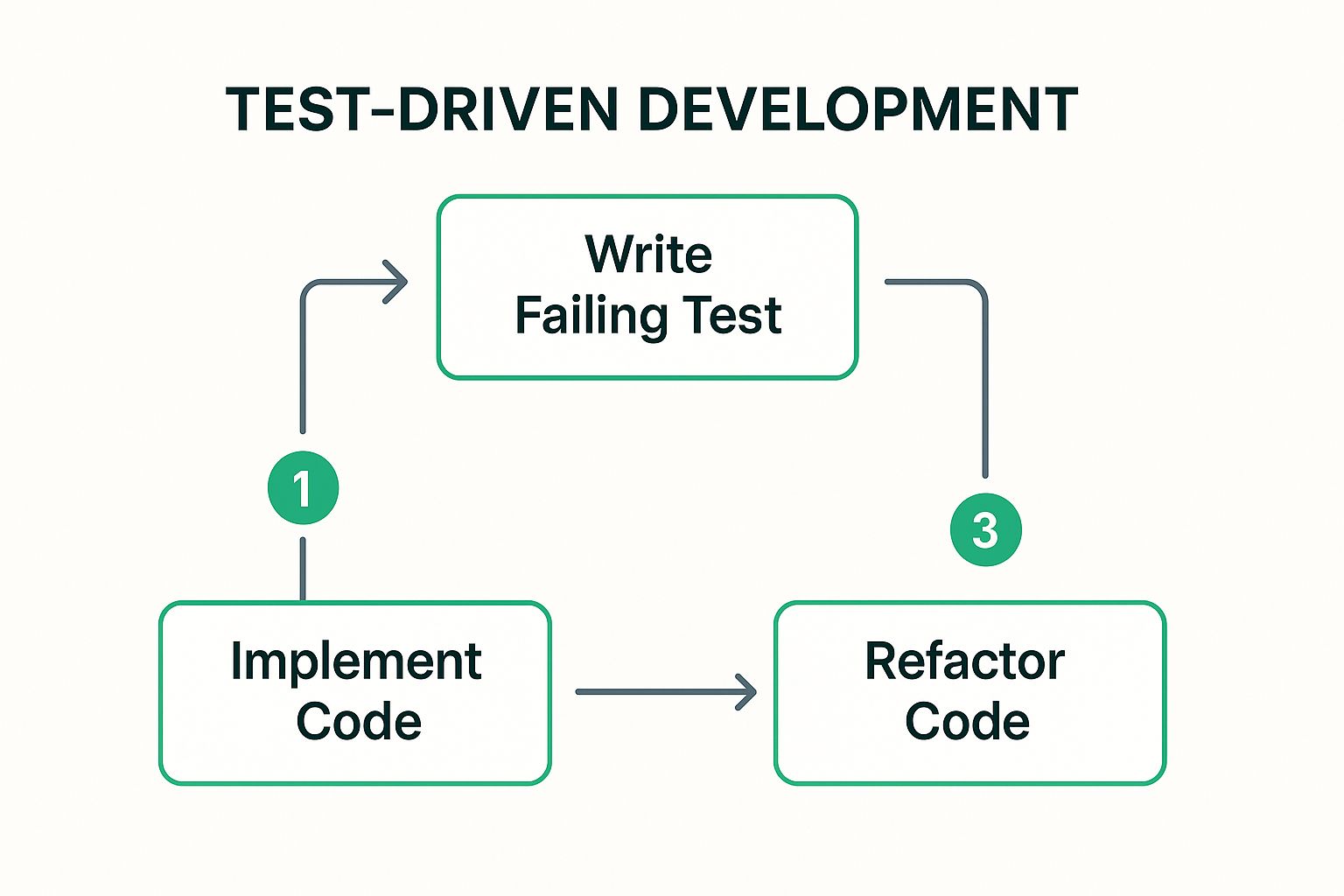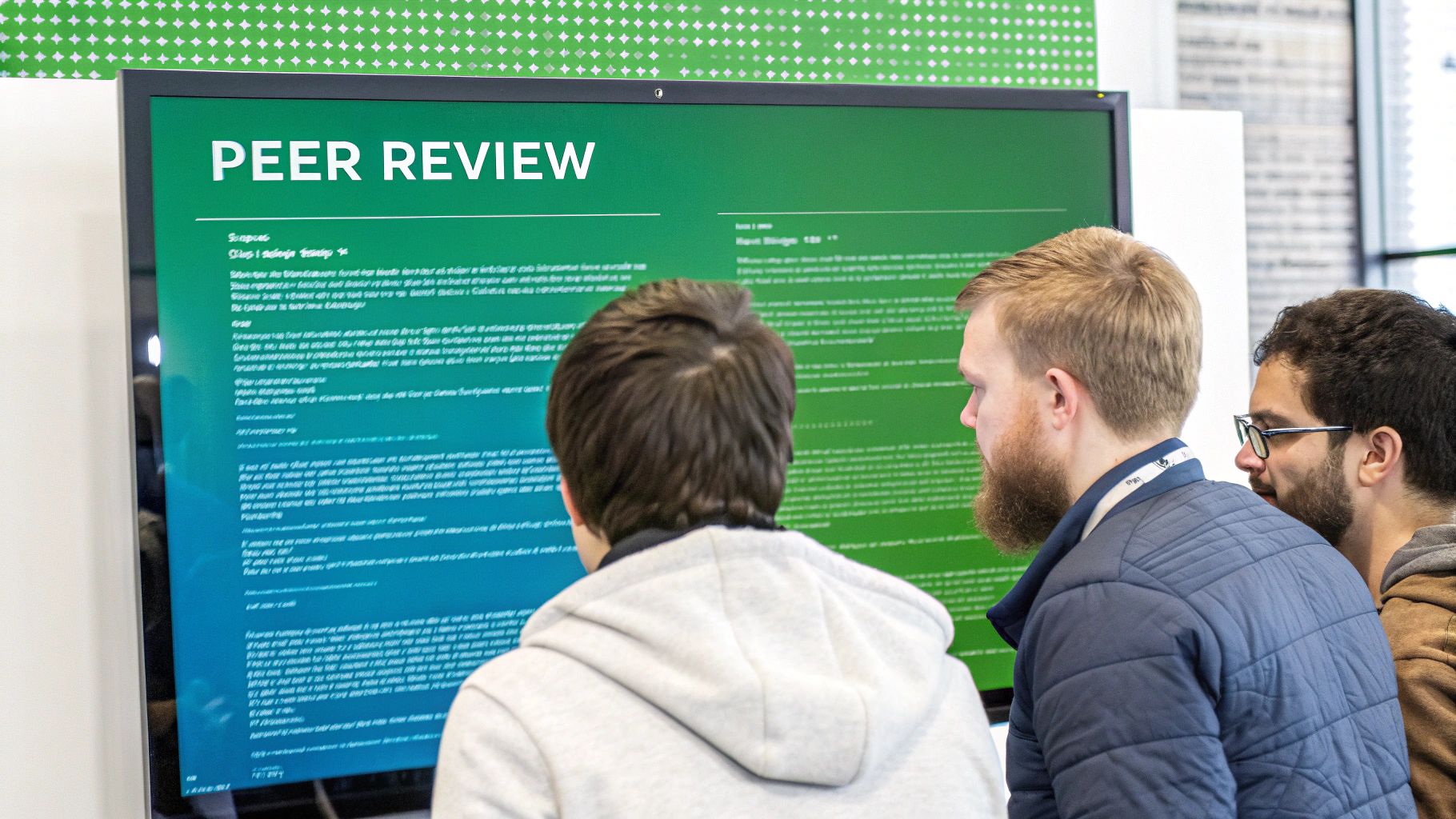Discover the top 9 improve code quality strategies and tips. Complete guide with actionable insights.
High-quality code isn’t just nice to have; it’s crucial for the long-term success of any software project. Poor code quality leads to bugs, security vulnerabilities, and increased maintenance costs. It hampers scalability and makes collaboration a nightmare. This listicle provides a curated collection of practical steps you can take to improve code quality immediately. We’ll cover techniques spanning the entire software development lifecycle, from initial design to deployment and maintenance. This list offers actionable insights to enhance your coding practices and create robust, maintainable software. Understanding how these concepts intertwine is vital for creating a development process that consistently produces high-quality code. As you’re getting started, consider how team structure impacts code quality. Factors like communication, roles, and responsibilities play a significant role. Here’s an article on effective software development team structure for insights into optimizing your team for better code.
We’ll explore the following key areas to improve code quality:
Each item will be explained with practical implementation details and specific examples, coupled with insights on how DocuWriter.ai features can streamline your workflow. By the end of this list, you will be equipped with practical strategies you can implement immediately to significantly improve code quality and build better software.
Test-Driven Development (TDD) is a software development approach where tests are written before the code they are intended to verify. This “test-first” approach fundamentally shifts the development process, ensuring code quality is baked in from the beginning. TDD follows a Red-Green-Refactor cycle. First, write a failing test (Red), defining the desired functionality. Then, write the minimal code necessary to make the test pass (Green). Finally, refactor both the test and production code for clarity and efficiency while ensuring the tests remain green.
This iterative process not only improves code quality but also encourages cleaner design and better documentation through the tests themselves. Companies like Spotify, Microsoft, and Netflix have successfully implemented TDD, demonstrating its effectiveness in diverse projects, from payment processing to recommendation algorithms. TDD proves particularly valuable in complex systems where thorough testing is paramount to prevent regressions and ensure reliability.
Adopting TDD requires a disciplined approach. Begin with small, focused tests targeting specific functionalities before tackling more complex scenarios. Concentrate on testing the behavior of the code rather than its internal implementation. This approach improves code flexibility and maintainability by minimizing the impact of future changes.
The following infographic visualizes the cyclical nature of the TDD process.

The infographic illustrates the core TDD loop: Write Failing Test, Implement Code, and Refactor Code. The cyclical nature, emphasized by the looping arrows, highlights the iterative nature of the TDD process, ensuring continuous improvement and high code quality. DocuWriter.ai can further enhance the TDD workflow by automatically generating documentation from the tests, further improving code maintainability and communication within development teams. By integrating automated documentation and refactoring tools, developers can streamline the Red-Green-Refactor cycle and maximize the benefits of TDD for improved code quality.
Code reviews are a systematic examination of source code by peers before it’s merged into the main codebase. This process involves developers analyzing each other’s code changes to identify potential bugs, ensure adherence to coding standards, share knowledge, and ultimately improve overall code quality. Code reviews act as a crucial quality gate, preventing defects from reaching production and fostering a culture of shared responsibility. They also facilitate knowledge transfer within the team.

Companies like Google (with their Critique system) and Microsoft (using Azure DevOps pull requests) have integrated code reviews into their workflows, demonstrating the scalability and effectiveness of this practice. Even the open-source Linux kernel development relies heavily on rigorous patch reviews. This widespread adoption highlights the value of code reviews in projects of all sizes and complexities, from web applications to operating systems. Learn more about code review best practices at this link.
Effective code reviews require more than just pointing out errors. They should be a constructive process focused on improvement and collaboration. Here are some key tips for conducting successful code reviews:
By adhering to these best practices, code reviews become a powerful tool for improving code quality, fostering collaboration, and building a stronger development team. Tools like DocuWriter.ai can further enhance this process by automatically generating documentation from code, reducing the documentation burden and ensuring consistency. Integrating such tools streamlines the review process and allows reviewers to concentrate on the core logic and quality of the code.
Static code analysis is the process of evaluating source code without actually running it. This automated inspection identifies potential issues like bugs, security vulnerabilities, code smells, and deviations from coding standards. Static analysis tools examine the code’s structure, syntax, and patterns, catching problems early in the development cycle before they become costly to fix. This provides a layer of automated quality assurance that complements manual code reviews, improving code quality proactively.
Companies like Airbnb, Uber, and Netflix leverage static analysis extensively, demonstrating its value in diverse environments. Airbnb uses ESLint with custom rules for JavaScript, while Uber utilizes multiple tools across their complex codebase. Netflix integrates static analysis into their CI/CD pipeline for continuous quality monitoring. These organizations, along with over 200,000 others using platforms like SonarQube, showcase the effectiveness of static analysis in ensuring code quality and security at scale. This technique proves particularly valuable in large projects or rapidly evolving codebases where maintaining consistency and preventing defects are crucial for long-term success.
Integrating static analysis seamlessly into the development workflow requires a strategic approach. Begin with less stringent rules and gradually increase the strictness as the team adapts. Direct integration with IDEs provides immediate feedback, facilitating rapid correction. Focus on critical issues that directly impact functionality or security, avoiding unnecessary noise.
Using DocuWriter.ai can streamline the interpretation of static analysis results by automatically generating documentation that highlights potential issues. This facilitates communication and collaboration within development teams, ensuring efficient resolution and improved code quality.
Refactoring is the disciplined practice of improving code structure, readability, and design without changing its external behavior or functionality. It involves systematic code transformations that eliminate code smells, reduce complexity, and improve maintainability, making code more expressive while preserving existing functionality through comprehensive testing. Companies like Shopify, Slack, and Twitter have all benefited from strategic refactoring initiatives, improving the maintainability and scalability of their platforms. Refactoring is essential for long-term project health and allows developers to adapt to evolving requirements and prevent code rot.
Adopting refactoring into the development workflow requires a methodical and test-driven approach. Start with small, focused changes, ensuring existing tests cover the refactored code. Leverage IDE refactoring tools for safe, automated transformations, and document the reasoning behind major refactoring decisions for future maintainability. Regularly scheduled refactoring sessions help to prevent technical debt from accumulating.
Learn more about Refactoring. DocuWriter.ai can support refactoring efforts by automatically updating documentation to reflect code changes, keeping documentation synchronized and reducing manual effort. By integrating refactoring tools and automated documentation, developers can streamline the process and ensure code quality improvements are effectively documented and communicated.
Continuous Integration/Continuous Deployment (CI/CD) is a software development practice that automates building, testing, and deploying code changes frequently and reliably. CI/CD pipelines ensure code changes are continuously integrated into the main branch and automatically tested. These changes are then deployed to production environments with minimal manual intervention, enabling faster and more reliable software delivery. This process improves code quality by catching errors early and often.

Companies like Netflix, Amazon, and Etsy leverage sophisticated CI/CD pipelines, demonstrating its effectiveness in handling frequent deployments and maintaining high code quality. Netflix, for example, deploys thousands of times per day. Amazon’s deployment system handles deployments every 11.7 seconds. This highlights the scalability and robustness CI/CD offers for complex systems.
Adopting CI/CD requires a strategic approach and commitment to automation. Begin with a simple CI pipeline and gradually increase complexity. Focus on maintaining rapid feedback loops with quick-running tests to ensure early error detection.
By automating these crucial steps, CI/CD minimizes human error, increases deployment frequency, and ensures continuous improvement of code quality. DocuWriter.ai can further enhance the CI/CD workflow by generating documentation from the automated tests, promoting better code maintainability and communication within development teams.
Coding standards and style guides are established conventions that dictate how code should be written and structured within a project. These guidelines cover aspects like naming conventions, code organization, commenting practices, and even stylistic choices like indentation and spacing. By enforcing consistency across the codebase, style guides significantly improve code readability and maintainability, making collaboration smoother and reducing the likelihood of errors. This contributes directly to improved code quality by making the code easier to understand, review, and modify.
Examples of widely adopted coding standards include Google’s comprehensive style guides for multiple languages, Airbnb’s influential JavaScript style guide, and PEP 8 for Python. These standards offer a solid foundation for teams looking to establish their own guidelines. To further streamline your development pipeline, consider exploring the benefits of Jira workflow automation. Effective workflow automation can free up developers to focus on writing high-quality code.
Adopting and adhering to coding standards requires a disciplined approach. Begin by choosing an established industry standard as a baseline rather than creating one from scratch. Leverage automated formatting tools, like Prettier or ESLint, to ensure consistent style enforcement across the team. Prioritize readability and maintainability over personal preferences when defining rules.
Consistent application of coding standards reduces the cognitive load on developers, enabling them to focus on the logic and functionality of the code rather than deciphering inconsistent formatting. This, in turn, leads to higher code quality and fewer bugs. DocuWriter.ai can complement this by automating documentation based on consistent code structure, further improving maintainability.
Design patterns are reusable solutions to recurring software design and architecture problems. They offer proven templates for addressing design challenges, thereby promoting code reusability, maintainability, and improved communication among developers. Essentially, design patterns encapsulate best practices evolved over time, helping developers avoid reinventing the wheel while constructing more robust and flexible software architectures. Leveraging design patterns helps improve code quality by providing established solutions to common problems.
Frameworks like Spring and React leverage design patterns extensively. Spring utilizes Dependency Injection and Factory patterns, while React implements the Observer pattern for state management. Other examples include Model-View-Controller (MVC) in Ruby on Rails and ASP.NET, Singleton for database connection management, Command in GUI applications and undo functionality, and Strategy in payment processing systems. These practical applications demonstrate the versatility and effectiveness of design patterns across diverse software projects.
Applying design patterns requires careful consideration. Blindly applying patterns without understanding the underlying problem can lead to unnecessary complexity. Choosing the right pattern involves understanding the problem’s context and selecting the most appropriate solution.
DocuWriter.ai can facilitate the effective use of design patterns by generating documentation that clarifies their implementation and purpose within a project. This enhances code understanding and maintainability, maximizing the benefits of using design patterns for improved code quality. By providing clear documentation, DocuWriter.ai empowers developers to leverage design patterns more effectively and consistently.
Documentation and code comments are essential for improving code quality. Clear, comprehensive documentation and meaningful code comments explain the purpose, functionality, and usage of code, ensuring maintainability and facilitating team collaboration. Good documentation includes inline comments for complex logic, API documentation, architecture overviews, and even user guides. This practice allows future developers (including your future self) to understand and modify the codebase effectively.